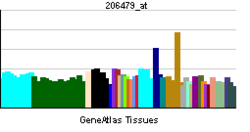TRPM1
| View/Edit Human | View/Edit Mouse |
Transient receptor potential cation channel subfamily M member 1 is a protein that in humans is encoded by the TRPM1 gene.[4][5][6]
Function
The protein encoded by this gene is a member of the transient receptor potential (TRP) family of non-selective cation channels. The expression of this protein is inversely correlated with melanoma aggressiveness, suggesting that it suppresses melanoma metastasis.[7] The expression of the TRPM1 gene is regulated by the Microphthalmia-associated transcription factor.[8][9]
Clinical significance
Mutations in TRPM1 are associated with congenital stationary night blindness in humans [10][11][12][13] and coat spotting patterns in Appaloosa horses.[14]
See also
References
- ↑ "Drugs that physically interact with Transient receptor potential cation channel subfamily M member 1 view/edit references on wikidata".
- ↑ "Human PubMed Reference:".
- ↑ "Mouse PubMed Reference:".
- ↑ Hunter JJ, Shao J, Smutko JS, Dussault BJ, Nagle DL, Woolf EA, Holmgren LM, Moore KJ, Shyjan AW (Nov 1998). "Chromosomal localization and genomic characterization of the mouse melastatin gene (Mlsn1)". Genomics. 54 (1): 116–23. doi:10.1006/geno.1998.5549. PMID 9806836.
- ↑ Duncan LM, Deeds J, Hunter J, Shao J, Holmgren LM, Woolf EA, Tepper RI, Shyjan AW (Apr 1998). "Down-regulation of the novel gene melastatin correlates with potential for melanoma metastasis". Cancer Research. 58 (7): 1515–20. PMID 9537257.
- ↑ Clapham DE, Julius D, Montell C, Schultz G (Dec 2005). "International Union of Pharmacology. XLIX. Nomenclature and structure-function relationships of transient receptor potential channels". Pharmacological Reviews. 57 (4): 427–50. doi:10.1124/pr.57.4.6. PMID 16382100.
- ↑ "Entrez Gene: TRPM1 transient receptor potential cation channel, subfamily M, member 1".
- ↑ Miller AJ, Du J, Rowan S, Hershey CL, Widlund HR, Fisher DE (Jan 2004). "Transcriptional regulation of the melanoma prognostic marker melastatin (TRPM1) by MITF in melanocytes and melanoma". Cancer Research. 64 (2): 509–16. doi:10.1158/0008-5472.CAN-03-2440. PMID 14744763.
- ↑ Hoek KS, Schlegel NC, Eichhoff OM, Widmer DS, Praetorius C, Einarsson SO, Valgeirsdottir S, Bergsteinsdottir K, Schepsky A, Dummer R, Steingrimsson E (Dec 2008). "Novel MITF targets identified using a two-step DNA microarray strategy". Pigment Cell & Melanoma Research. 21 (6): 665–76. doi:10.1111/j.1755-148X.2008.00505.x. PMID 19067971.
- ↑ Audo I, Kohl S, Leroy BP, Munier FL, Guillonneau X, Mohand-Saïd S, Bujakowska K, Nandrot EF, Lorenz B, Preising M, Kellner U, Renner AB, Bernd A, Antonio A, Moskova-Doumanova V, Lancelot ME, Poloschek CM, Drumare I, Defoort-Dhellemmes S, Wissinger B, Léveillard T, Hamel CP, Schorderet DF, De Baere E, Berger W, Jacobson SG, Zrenner E, Sahel JA, Bhattacharya SS, Zeitz C (Nov 2009). "TRPM1 is mutated in patients with autosomal-recessive complete congenital stationary night blindness". American Journal of Human Genetics. 85 (5): 720–9. doi:10.1016/j.ajhg.2009.10.013. PMC 2775830
 . PMID 19896113.
. PMID 19896113. - ↑ Li Z, Sergouniotis PI, Michaelides M, Mackay DS, Wright GA, Devery S, Moore AT, Holder GE, Robson AG, Webster AR (Nov 2009). "Recessive mutations of the gene TRPM1 abrogate ON bipolar cell function and cause complete congenital stationary night blindness in humans". American Journal of Human Genetics. 85 (5): 711–9. doi:10.1016/j.ajhg.2009.10.003. PMC 2775833
 . PMID 19878917.
. PMID 19878917. - ↑ Nakamura M, Sanuki R, Yasuma TR, Onishi A, Nishiguchi KM, Koike C, Kadowaki M, Kondo M, Miyake Y, Furukawa T (2010). "TRPM1 mutations are associated with the complete form of congenital stationary night blindness". Molecular Vision. 16: 425–37. PMC 2838739
 . PMID 20300565.
. PMID 20300565. - ↑ van Genderen MM, Bijveld MM, Claassen YB, Florijn RJ, Pearring JN, Meire FM, McCall MA, Riemslag FC, Gregg RG, Bergen AA, Kamermans M (Nov 2009). "Mutations in TRPM1 are a common cause of complete congenital stationary night blindness". American Journal of Human Genetics. 85 (5): 730–6. doi:10.1016/j.ajhg.2009.10.012. PMC 2775826
 . PMID 19896109.
. PMID 19896109. - ↑ Bellone RR, Brooks SA, Sandmeyer L, Murphy BA, Forsyth G, Archer S, Bailey E, Grahn B (Aug 2008). "Differential gene expression of TRPM1, the potential cause of congenital stationary night blindness and coat spotting patterns (LP) in the Appaloosa horse (Equus caballus)". Genetics. 179 (4): 1861–70. doi:10.1534/genetics.108.088807. PMC 2516064
 . PMID 18660533.
. PMID 18660533.
External links
- TRPM1 protein, human at the US National Library of Medicine Medical Subject Headings (MeSH)
This article incorporates text from the United States National Library of Medicine, which is in the public domain.
